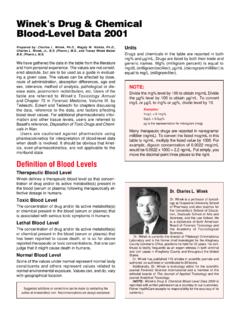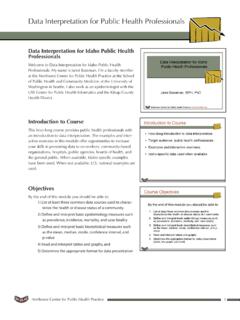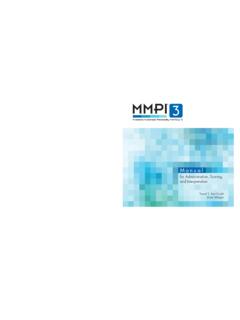Transcription of S2 (R1) Step 5 Genotoxicity testing and data ...
1 June 2012 EMA/CHMP/ICH/126642/2008 ICH guideline S2 (R1) on Genotoxicity testing and data interpretation for pharmaceuticals intended for human use Step 5 Transmission to CHMP March 2008 Adoption by CHMP for release for consultation March 2008 End of consultation (deadline for comments) May 2008 Final adoption by CHMP December 2011 Date for coming into effect June 2012 7 Westferry Circus Canary Wharf London E14 4HB United Kingdom An agency of the European Union Telephone +44 (0)20 7418 8400 Facsimile +44 (0)20 7418 8416 E-mail Website European Medicines Agency, 2013. Reproduction is authorised provided the source is acknowledged. S2 (R1) on Genotoxicity testing and data interpretation for pharmaceuticals intended for human use Table of contents 1. Introduction .. 4 Objectives of the guideline .. 4 Background .. 4 Scope of the guideline .. 4 General principles.
2 4 2. The standard test battery for Genotoxicity .. 5 Rationale .. 5 Description of the two options for the standard battery .. 5 Modifications to the test battery .. 7 Exploratory clinical studies .. 7 testing compounds that are toxic to bacteria .. 7 Compounds bearing structural alerts for genotoxic activity .. 7 Limitations to the use of in vivo 7 Detection of germ cell mutagens .. 8 3. Recommendations for in vitro tests .. 8 Test repetition and interpretation .. 8 Recommended protocol for the bacterial mutation assay .. 8 Selection of top dose level .. 8 Study design/Test protocol .. 8 Recommended protocols for the mammalian cell assays .. 9 Selection of top concentration .. 9 Study design/Test protocols .. 9 Positive controls .. 10 4. Recommendations for in vivo tests .. 10 Tests for the detection of chromosome damage in vivo .. 10 Other in vivo Genotoxicity tests.
3 10 Dose selection for in vivo assays .. 11 Short-term studies .. 11 Multiple administration studies .. 11 testing compounds that are toxic for blood or bone marrow .. 12 Demonstration of target tissue exposure for negative in vivo test results .. 12 When an in vitro Genotoxicity test is positive (or not done) .. 12 When in vitro Genotoxicity tests are negative .. 13 Sampling times for in vivo assays .. 13 Number of animals analyzed .. 14 Use of male/female rodents in in vivo Genotoxicity tests .. 14 ICH guideline S2 (R1) on Genotoxicity testing and data interpretation for pharmaceuticals intended for human use EMA/CHMP/ICH/126642/2008 Page 2/28 Route of administration .. 14 Use of positive controls for in vivo studies .. 14 5. Guidance on evaluation of test results and on follow-up test strategies 14 Assessment of biological relevance .. 15 Evaluation of results obtained in in vitro tests.
4 15 Evaluation of positive results obtained in vitro in a bacterial mutation assay 15 Evaluation of positive results obtained in vitro in mammalian cell assays .. 15 Evaluation of in vitro negative results .. 16 Evaluation of results obtained from in vivo tests .. 16 Follow-up strategies for positive results .. 16 Follow-up to findings in vitro in mammalian cell tests .. 16 Follow-up to a positive in vivo micronucleus assay .. 18 Follow-up Genotoxicity testing in relation to tumour findings in a carcinogenicity bioassay .. 18 6. Notes .. 19 7. Glossary .. 24 8. 26 ICH guideline S2 (R1) on Genotoxicity testing and data interpretation for pharmaceuticals intended for human use EMA/CHMP/ICH/126642/2008 Page 3/28 1. Introduction Objectives of the guideline This guidance replaces and combines the ICH S2A and S2B guidelines. The purpose of the revision is to optimize the standard genetic toxicology battery for prediction of potential human risks, and to provide guidance on interpretation of results, with the ultimate goal of improving risk characterization for carcinogenic effects that have their basis in changes in the genetic material.
5 The revised guidance describes internationally agreed upon standards for follow-up testing and interpretation of positive results in vitro and in vivo in the standard genetic toxicology battery, including assessment of non-relevant findings. This guidance is intended to apply only to products being developed as human pharmaceuticals. Background The recommendations from the latest Organization for Economic Co-operation and Development (OECD) guidelines and the reports from the International Workshops on Genotoxicity testing (IWGT) have been considered where relevant. In certain cases, there are differences from the OECD or IWGT recommendations, which are noted in the text. The following notes for guidance should be applied in conjunction with other ICH guidances. Scope of the guideline The focus of this guidance is testing of new small molecule drug substances, and the guidance does not apply to biologics.
6 Advice on the timing of the studies relative to clinical development is provided in the ICH M3 (R2) guidance. General principles Genotoxicity tests can be defined as in vitro and in vivo tests designed to detect compounds that induce genetic damage by various mechanisms. These tests enable hazard identification with respect to damage to DNA and its fixation. Fixation of damage to DNA in the form of gene mutations, larger scale chromosomal damage or recombination is generally considered to be essential for heritable effects and in the multi-step process of malignancy, a complex process in which genetic changes might possibly play only a part. Numerical chromosome changes have also been associated with tumorigenesis and can indicate a potential for aneuploidy in germ cells. Compounds that are positive in tests that detect such kinds of damage have the potential to be human carcinogens and/or mutagens.
7 Because the relationship between exposure to particular chemicals and carcinogenesis is established for humans, whilst a similar relationship has been difficult to prove for heritable diseases, Genotoxicity tests have been used mainly for the prediction of carcinogenicity. Nevertheless, because germ line mutations are clearly associated with human disease, the suspicion that a compound might induce heritable effects is considered to be just as serious as the suspicion that a compound might induce cancer. In addition, the outcome of Genotoxicity tests can be valuable for the interpretation of carcinogenicity studies. ICH guideline S2 (R1) on Genotoxicity testing and data interpretation for pharmaceuticals intended for human use EMA/CHMP/ICH/126642/2008 Page 4/28 2. The standard test battery for Genotoxicity Rationale Registration of pharmaceuticals requires a comprehensive assessment of their genotoxic potential.
8 Extensive reviews have shown that many compounds that are mutagenic in the bacterial reverse mutation (Ames) test are rodent carcinogens. Addition of in vitro mammalian tests increases sensitivity for detection of rodent carcinogens and broadens the spectrum of genetic events detected, but also decreases the specificity of prediction; , increases the incidence of positive results that do not correlate with rodent carcinogenicity. Nevertheless, a battery approach is still reasonable because no single test is capable of detecting all genotoxic mechanisms relevant in tumorigenesis. The general features of a standard test battery are as follows: i. Assessment of mutagenicity in a bacterial reverse gene mutation test. This test has been shown to detect relevant genetic changes and the majority of genotoxic rodent and human carcinogens. ii. Genotoxicity should also be evaluated in mammalian cells in vitro and/or in vivo as follows.
9 Several in vitro mammalian cell systems are widely used and can be considered sufficiently validated: The in vitro metaphase chromosome aberration assay, the in vitro micronucleus assay (note 1) and the mouse lymphoma L5178Y cell Tk (thymidine kinase) gene mutation assay (MLA). These three assays are currently considered equally appropriate and therefore interchangeable for measurement of chromosomal damage when used together with other Genotoxicity tests in a standard battery for testing of pharmaceuticals, if the test protocols recommended in this guideline are used. In vivo test(s) are included in the test battery because some agents are mutagenic in vivo but not in vitro (note 2) and because it is desirable to include assays that account for such factors as absorption, distribution, metabolism and excretion. The choice of an analysis either of micronuclei in erythrocytes (in blood or bone marrow), or of chromosome aberrations in metaphase cells in bone marrow, is currently included for this reason (note 3).
10 Lymphocytes cultured from treated animals can also be used for cytogenetic analysis, although experience with such analyses is less widespread. In vitro and in vivo tests that measure chromosomal aberrations in metaphase cells can detect a wide spectrum of changes in chromosomal integrity. Breakage of chromatids or chromosomes can result in micronucleus formation if an acentric fragment is produced; therefore assays that detect either chromosomal aberrations or micronuclei are considered appropriate for detecting clastogens. Micronuclei can also result from lagging of one or more whole chromosome(s) at anaphase and thus micronucleus tests have the potential to detect some aneuploidy inducers. The MLA detects mutations in the Tk gene that result from both gene mutations and chromosome damage. There is some evidence that MLA can also detect chromosome loss. There are several additional in vivo assays that can be used in the battery or as follow-up tests to develop weight of evidence in assessing results of in vitro or in vivo assays (see below).
















